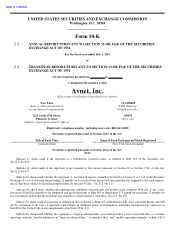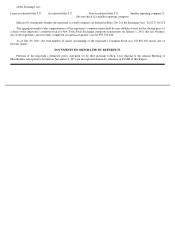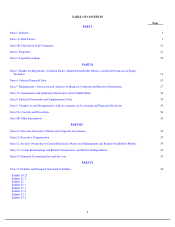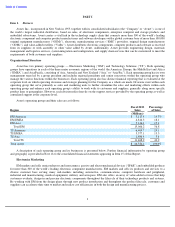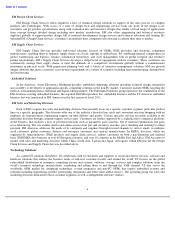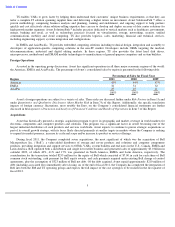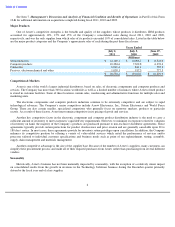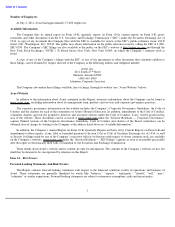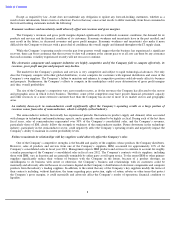Avnet 2011 Annual Report Download - page 12
Download and view the complete annual report
Please find page 12 of the 2011 Avnet annual report below. You can navigate through the pages in the report by either clicking on the pages listed below, or by using the keyword search tool below to find specific information within the annual report.
Table of Contents
Declines in the value of the Company’s inventory or unexpected order cancellations by the Company’
s customers could
materially and adversely affect its business, results of operations, financial condition and liquidity.
The electronic components and computer products industries are subject to rapid technological change, new and enhanced
products and evolving industry standards, which can contribute to a decline in value or obsolescence of inventory. Regardless of the
general economic environment, it is possible that prices will decline due to a decrease in demand or an oversupply of products and, as
a result of the price declines, there may be greater risk of declines in inventory value. Although it is the policy of many of the
Company’
s suppliers to offer distributors like Avnet certain protections from the loss in value of inventory (such as price protection
and limited rights of return), the Company cannot be assured that such policies will fully compensate for the loss in value, or that the
vendors will choose to, or be able to, honor such agreements, some of which are not documented and, therefore, subject to the
discretion of the vendor. In addition, the Company’
s sales are typically made pursuant to individual purchase orders, and the Company
generally does not have long-term supply arrangements with its customers. Generally, the Company’
s customers may cancel orders
30 days prior to shipment with minimal penalties. The Company cannot be assured that unforeseen new product developments,
declines in the value of the Company’
s inventory or unforeseen order cancellations by its customers will not materially and adversely
affect the Company’s business, results of operations, financial condition or liquidity.
Substantial defaults by the Company’
s customers on its accounts receivable or the loss of significant customers could have a
significant negative impact on the Company’s business, results of operations, financial condition or liquidity.
A significant portion of the Company’
s working capital consists of accounts receivable from customers. If customers responsible
for a significant amount of accounts receivable were to become insolvent or otherwise unable to pay for products and services, or were
to become unwilling or unable to make payments in a timely manner, the Company’
s business, results of operations, financial
condition or liquidity could be adversely affected. An economic or industry downturn could adversely and materially affect the
servicing of these accounts receivable, which could result in longer payment cycles, increased collection costs and defaults in excess
of management’s expectations. A significant deterioration in the Company’
s ability to collect on accounts receivable could also impact
the cost or availability of financing under its accounts receivable securitization program (see Financing Transactions
appearing in
Item 7 of this Report).
The Company’s non-
U.S. locations represent a significant and growing portion of its revenue, and consequently, the Company is
increasingly exposed to risks associated with operating internationally.
During fiscal year 2011, 2010 and 2009, approximately 62%, 60% and 58%, respectively, of the Company’
s sales came from its
operations outside the United States. As a result of the Company’
s foreign sales and locations, in particular those in emerging and
developing economies, the Company’
s operations are subject to a variety of risks that are specific to international operations,
including, but not limited to, the following:
9
•
potential restrictions on the Company
’
s ability to repatriate funds from its foreign subsidiaries;
•
foreign currency and interest rate fluctuations and the impact on the Company
’
s reported results of operations;
•
import and export duties and value
-
added taxes;
•
compliance with foreign and domestic import and export regulations, business licensing requirements and anti-
corruption
laws, the failure of which could result in severe penalties including monetary fines, criminal proceedings and suspension of
export privileges;
•
changing tax laws and regulations;
•
regulatory requirements and prohibitions that differ between jurisdictions;
•
political instability, terrorism and potential military conflicts or civilian unrest;
•
fluctuations in freight costs, limitations on shipping and receiving capacity, and other disruptions in the transportation and
shipping infrastructure;
•
differing environmental regulations and employment practices and labor issues; and
•
the risk of non
-
compliance with local laws.



